This fermented honey garlic is the perfect thing to make to boost your immune system! Both honey and garlic have strong medicinal benefits, so you’ll want to have this delicious home remedy on hand for cold and flu season.
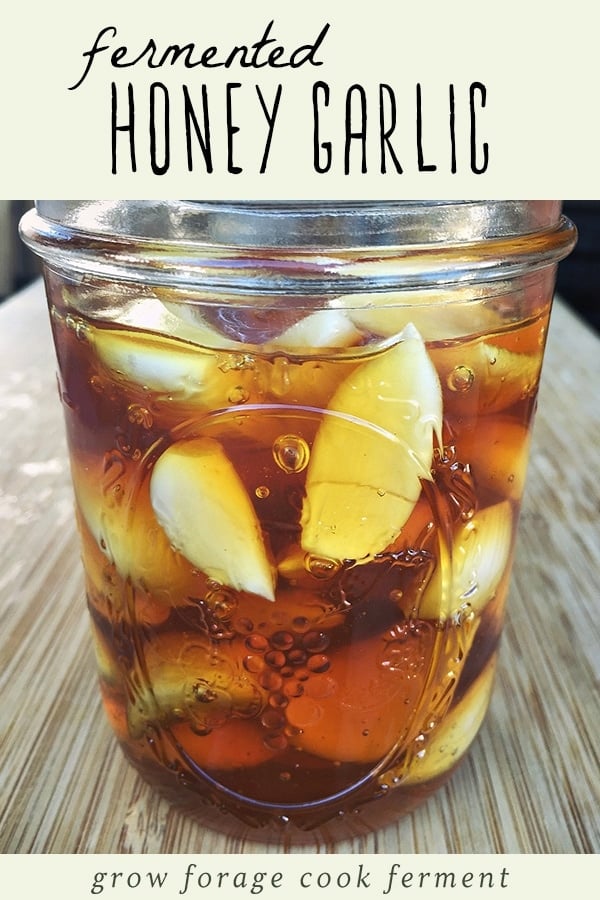
Want to save this post for later?
Fermenting Garlic in Honey
I’m really excited to share this post with you! Fermented honey garlic is something I’ve been wanting to try for a very long time.
I usually reserve my honey for mead making, but using it for other ferments intrigued me. Don’t ask me why I haven’t done it until now, because it’s the easiest thing in the world!
This tasty fermented garlic in honey can be used for many things, as good food and good medicine. Honestly though, I like to just eat it as is!
Fermented Honey Garlic Recipe
Making fermented honey garlic is so easy, it hardly needs a recipe!
Prepare the Garlic
The hardest and most time consuming part is prepping all of the garlic. Whatever size jar you use, you’ll want to fill it about 1/2-3/4 full of peeled garlic.
The quickest and easiest way to prep garlic is to place the side of a chef’s knife on top of a single clove and then give it a firm whack with the palm of your hand.
Don’t do it too hard, as you don’t want to crush the garlic, but just enough to lightly bruise the it. This will make it easy to peel, and will also release a bit of the garlic juice.
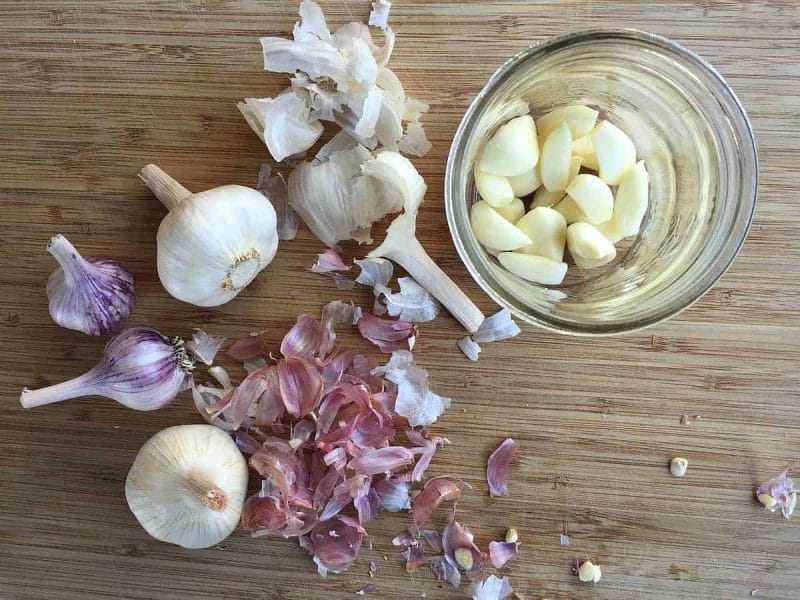
Add the Honey
Once you have enough garlic in your jar, pour in some raw honey to cover it. The garlic will probably float a bit and that’s ok.
It’s important to use raw honey to make fermented garlic in honey, as it will still have all the bacteria and wild yeast that is necessary for fermentation.
When liquid is added to honey, it jump starts the fermentation process. The small amount of juice from the garlic will create just enough liquid for fermentation to happen.
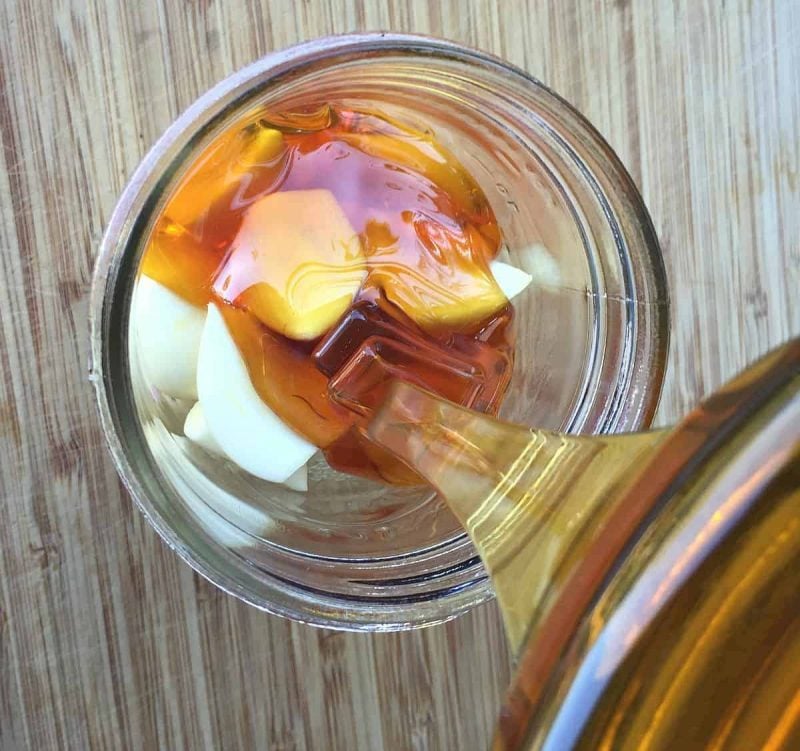
Cover and Flip
Cover the jar loosely with a lid to let the gasses escape, and put it in a dark place to ferment.
It’s a good idea to put a plate or something similar underneath the jar as it’s fermenting, as it will likely bubble up a bit and a little honey could possibly drip out.
It’s also important to gently turn the jar over every day or so, or whenever you think about it, to make sure that all of the garlic stay coated with honey.
Screw the lid on tightly before you do this! Then return it to it’s upright position and re-loosen the lid.
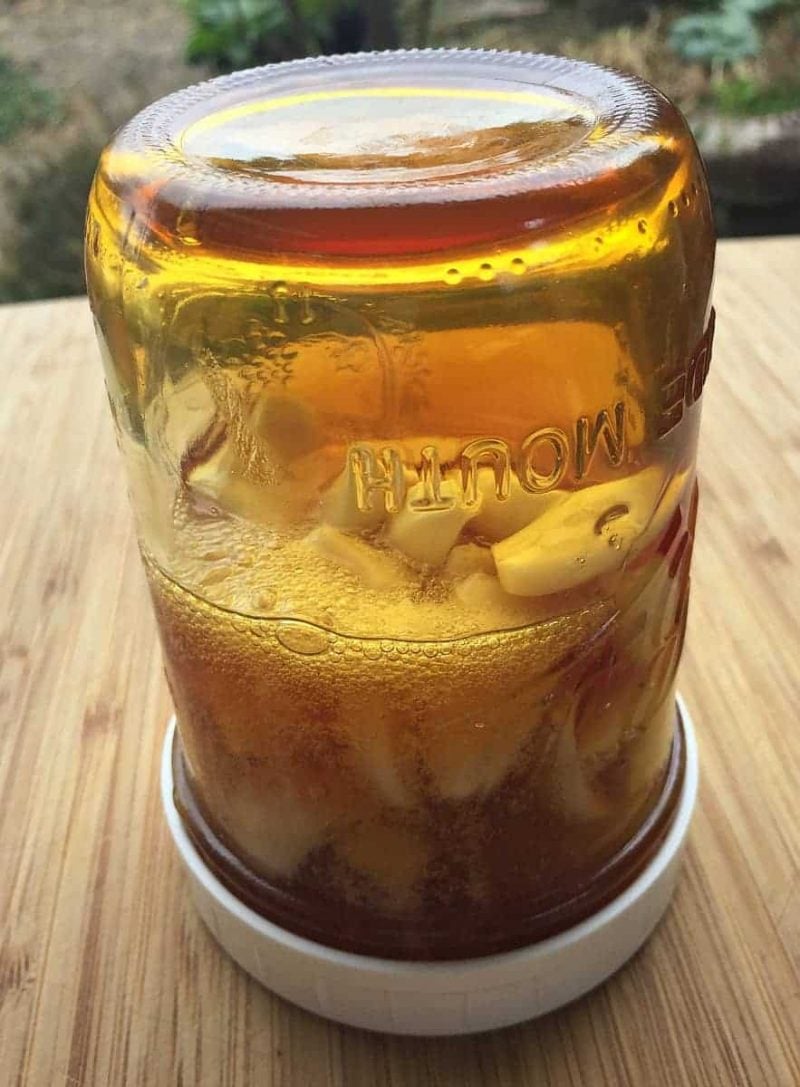
In a few days to a week you will notice some bubbles forming on the surface of the honey. Hooray!
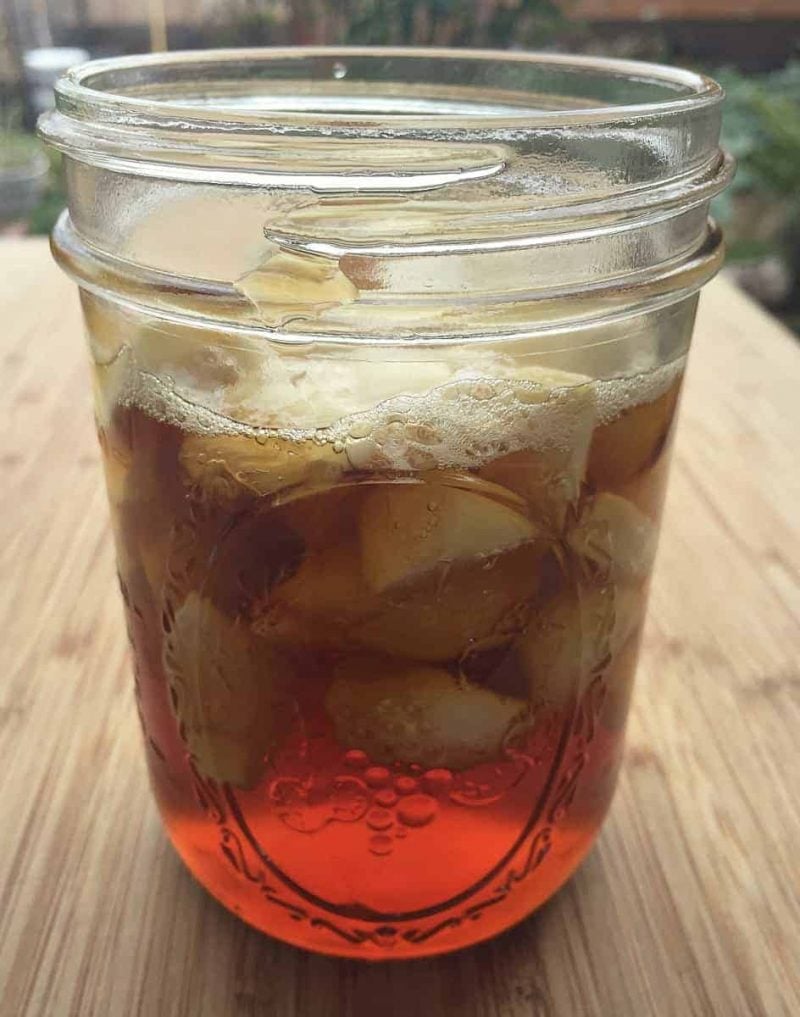
The honey garlic will ferment for about a month, but you can eat it at any time during the process.
The flavor will continue to develop over time, the garlic will mellow, and the honey will become much runnier.
Occasionally the garlic cloves turn a blue or green color due to a reaction during the fermentation process. While it may be a bit alarming, it is not harmful and the honey garlic can still be used.
Honey garlic will store well in a cool place for many months, or even a year or longer! I’ve kept some for over two years and it is still good.
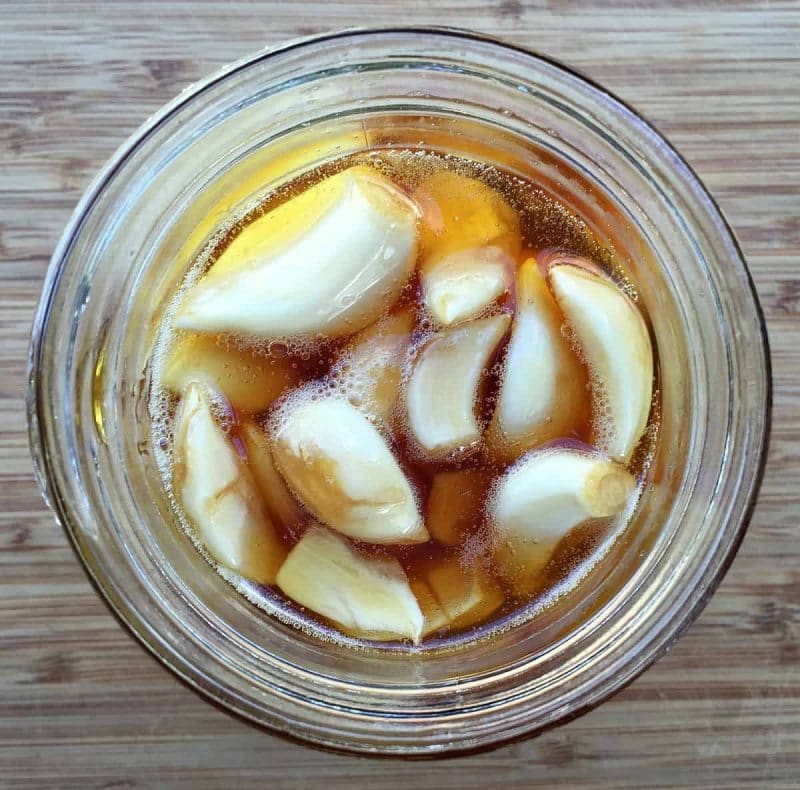
Using Fermented Honey Garlic
Now, how do you use this fermented honey garlic? That’s a good question, and it can be used in a variety of ways.
Both garlic and honey have strong medicinal properties, so it makes sense to use it as an immune booster or if you feel a cold or flu coming on.
Pop a whole garlic clove, or take a spoonful of honey (or both!).
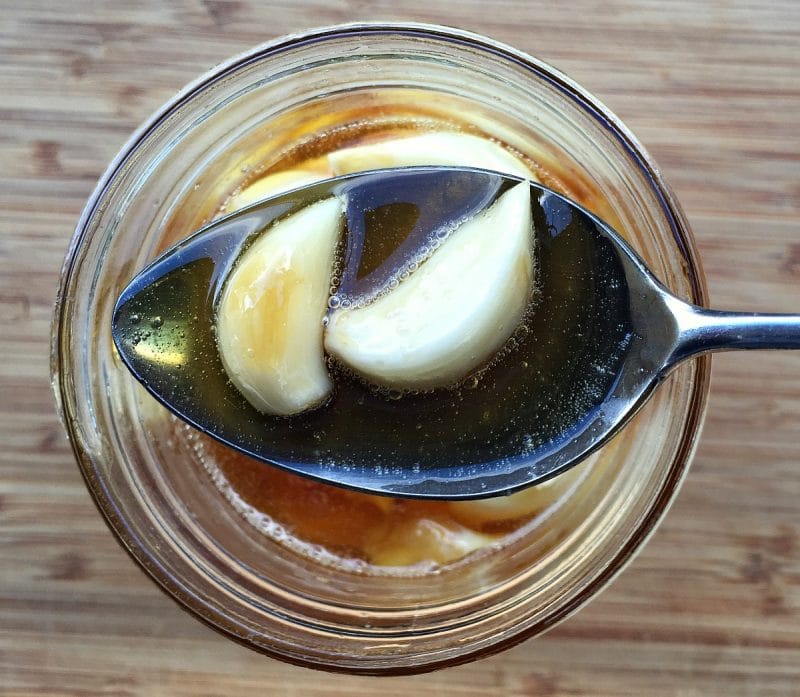
As you can probably imagine, honey garlic also makes a wonderful food!
It’s a natural in marinades and sauces, and would make a really tasty glaze for meats or veggies. Basically anything where you would normally use honey and garlic together!
Is Botulism a Concern in Honey Garlic?
I get this question a lot about fermented honey garlic! The short answer is no, botulism is really not a concern in this type of ferment.
While botulism can happen in garlic and oil preparations without added acidity, the fermentation process that happens here makes it very unlikely.
Raw honey is acidic, and while it can carry botulism spores (which is why it is not recommended for babies under 1 year), the level of acidity stops them from reproducing, which is what causes botulism.
If you are concerned about it, use a pH test strip. Botulism spores can’t reproduce with a pH of less than 4.6. Honey is usually around 3.9, but that can vary between brands.
If the pH is too high, add a splash of raw apple cider vinegar to add more acidity and retest. This is generally not needed, but I did want to mention it.
Honey garlic should not be given to babies under one year of age.
I really hope you make this yummy honeyed garlic! It’s super easy, and great to have on hand. I have a feeling it’s going to become a staple in our house!
Have you ever made fermented honey garlic? How do you use it?
More Fermented and Infused Honey Recipes
Enjoy these other recipes that showcase fermented and infused honey!
- Fermented Honey Cranberries
- Fermented Elderberry Honey
- Herbal Infused Honey
- Lilac Flower Infused Honey
Fermented Honey Garlic
Equipment
Ingredients
- 1 cup whole garlic cloves peeled and slightly crushed
- 1 cup raw honey or more, as needed to cover garlic
Instructions
- Place the peeled garlic cloves into a wide-mouth pint sized mason jar. Add enough honey to completely cover the garlic cloves. Make sure they are coated with honey.
- Place the lid on the jar loosely, then tuck into a dark place.
- Every day or so, tighten the lid on the jar and flip it upside down to coat the garlic cloves with honey. Loosen the lid again when you return it to the upright position.
- Within a few days to a week, you should see small bubbles start to form on the surface of the honey.
- The honey garlic will ferment for about a month, but you can eat it at any time. The flavor will continue to develop over time, the garlic will mellow, and the honey will become much runnier.
- Store in a cool place for many months or even a year, if not longer.
Notes
- It’s important to use raw honey for this recipe, as it has all of the bacteria and wild yeast that is necessary for fermentation.
- The small amount of juice from the garlic will create just enough liquid for fermentation to happen.
- It’s a good idea to put a plate underneath the jar during fermentation, as it will likely bubble up and a little bit of honey could possibly drip out.
- Occasionally the garlic cloves turn a bluish or greenish color during the fermentation process. While it may be a bit alarming, it is not harmful and the honey garlic can still be used.
- If you are concerned about botulism, use a pH test strip. Botulism spores can't reproduce with a pH of less than 4.6. Honey is usually around 3.9, but that can vary between brands.
- If the pH is too high, add a splash of raw apple cider vinegar to add more acidity and retest. This is generally not needed, but I do want to mention it.
- Honey garlic should not be given to babies under one year of age.

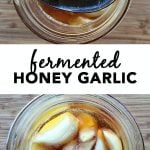
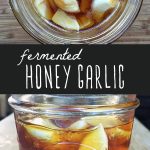
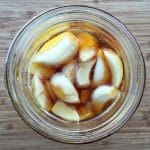

Just made my first batch with garlic from the garden. I found a young lady in my city whose husband is a beekeeper so I am very happy I’ve got a line in to raw honey. I have a compromised immune system so I’m looking forward to taking this everyday.
Hi! After the month of fermentation, do you store it with the lid on sealed tightly or continue to leave it loose the whole time?
After there are no more bubbles coming to the surface, I store it with the lid sealed.
I’m not seeing any bubbles form. It’s been a week. I used a plastic lid. Any suggestions on if this is still working?
Did you use organic garlic? Is the honey raw, never heated? If so, try moving your jar to a warmer area of your home.
Thanks for sharing this recipe! I’m 5 weeks in and I have a thick “sandy” composite build up at the bottom of my jar. I used an organic unfiltered honey. I’ve turned it upside down many times over the course of the 5 weeks. Is this okay? Not sure what to do or if this good.
Yes, it’s fine. It’s most likely crystallization. I would move somewhere a little warmer.
How long is it good for?
It’ll last a year or more when stored in a cool, dark pantry or cabinet.
I couldn’t fit enough honey in my jar for the 1:1 ratio initially. I used a very think raw honey. Left it for about 1/2 a day, saw it settled and garlic was peaking out, put it in the fridge and topped it off with more honey the next day. Do you think it’s safe? Once the honey had settled I already had some bubbles forming.
Hi Kayla. The honey garlic won’t ferment in the fridge. It needs to be a cool, dark pantry. As I say in the recipe, each day, you’ll need to tighten the lid and flip the jar to keep the garlic coated in honey. As long as there’s a thin layer of honey covering the garlic, it’s protected from spoilage.
I think I may not have put enough garlic and too much honey. I haven’t had any bubbles and it’s been almost a month. Can I add more garlic?
We often have just a plain green salad (lettuces only) as a side for dinner, and I always make our own salad dressing. I usually use a small amount of honey to sweeten, and also crushed garlic, so this is PERFECT for adding some (delicious) immunity-boosting into our family’s dinner!
Hypothetically… if someone forgot about the garlic. Is it still good? It’s hole-y. ?? How did I ruin this lol
Hole-y? I’m not sure what that means. I’ve kept a jar of fermented honey garlic for over a year and it’s totally fine.
I used your recipes for both jalapeno & garlic honey back on October 1st with local honey I purchased.
It’s been sitting in the same spot in my kitchen (not a dark pantry) ever since.
Just now when I opened the jar of jalapeno honey for the first time, it seemed like a little gas was released. And tiny bubbles are floating to the top
The garlic honey (which I added a few slices of jalapenos to) smells great! But the garlic is completely translucent? I haven’t taste tested either…
Do you recommend I toss it? or keep it??
Thank you so much in advance!! I love your page!
They are most likely fine, I’ve had jars for a year or more that still taste great. I would probably add a splash or two of apple cider vinegar to keep the pH low and prevent the risk of botulism.
Hi. Very excited to start this! Do you have to eat the garlic to get the full effect? And do you have to wait the entire 30 days before taking? We all currently have sinus infections and really want to avoid another round of antiotics.
Hi Holly. You don’t have to eat the garlic, but I think you’ll get more out of it if you do. I would wait to consume until your batch consistently bubbles for a week.
I am and curious if instead of whole cloves could I mince the garlic to ferment or is it better to use whole cloves?
You definitely can.
Followed all the steps & everything seemed to be going well until I noticed a sediment forming at the bottom of my jar, after about a month. Any idea if this is normal or concerning?
It’s most likely not sediment at all, but the honey separating. It’s totally normal.
Hello! At what point should you completely close your garlic honey…after the month of fermentation is complete?
Yup. As long as there aren’t any more bubbles coming to the service you can close the lid.
Do you eat the garlic clove and honey whole or do you chew it before swallowing?
Chew it, like food.
Hi there, I am reading a lot about sage as well….. what do you think of me adding some fresh organic sage leaves to the mixture??
You can add whatever you like!
So I’m curious, you mentioned the garlic occasionally turning blue/green during fermentation process, if this happens, can you still eat the garlic or is the garlic bad?
I have not tried this ferment yet but I am going to today and am just wondering.
Thank You so excited to try this
Yes, it’s completely fine and safe to eat.
would it be alright if I add a drop or two of essential oil? Thanks
That should be fine.
When you eat the honey garlic, does it make your breath smell bad or seep out of your pores? I work with someone who takes garlic daily and I swear I wanna gag every time he’s around. I do NOT want to smell like a garlic clove.
Not that I’m aware of.
Think you’ll find that it’s different for different people. For me normal garlic doesn’t make me smell, but elephant garlic (which is actually a type of leek) really does. You just have to try it and see.
We have enjoyed this! It has helped with eliminating the the advancement of any illness so far. I store mine in the fridge, is that a problem?
It should not be stored in the fridge. Honey is shelf stable at room temperature.
Hi. I fermented mine slightly differently. Because of the strong sulfer smell emitted during fermentation, I sealed the jar then took it outside twice (or more) times per day to burp the jar. After each burp, I retightened the lid and turned it upside down and back a couple times then put it back in the pantry. The pressure buildup was minimal and the results were great!
Can I add organic onions to the honey garlic fermentation?
Yup!
What room temperature is best for honey garlic fermentation?
70s.
Can you reuse the honey to ferment more garlic
No. It’s best to start a new jar each time to prevent cross contamination.
Wouldn’t it be better to use the honey along with the garlic during times of consumption? I know that honey is very beneficial & also healing. I have used a drop of organic honey in my eye when I had a problem, & a drop on my foot when I stepped on a nail.
Thanks for this. Other recipes didn’t mention the details (flipping and leakage prevention). I cannot wait to use this recipe as I have all my supplies ready and waiting.
After a month of room temp loose lid fermentation, should we store it in room temp or the refrigerator?
Room temperature, in a dark, cool place.
I am trying to ferment my garlic, but I don’t think i actually saw any bubbles forming. Our raw honey occasionally solidifies and we remelt in microwave, could that be my problem?
Hi Betsy. Microwaving honey is a bad idea. It’ll heat the honey too much and kill off any of the good bacteria. The best way to make honey liquid again is to set the jar in a bowl of warm water and very slowly let it melt.
Could a person use pickle pebbles and a wine making airlock while this ferments?
I haven’t tried, but you can give it a shot.
Can I add more honey to the jar after the garlic has already fermented? We are going through the honey really fast (I give to my kids when they are sick) and I still have lots of garlic cloves left. Thanks!
It’s best not to add more honey as it’ll increase your risk of cross contamination.
Can I add more garlic? It’s been fermenting for a month now but i didn’t put enough garlic initially
It’s best to start a new jar each time to prevent cross contamination.
How long will this keep? I made up a batch over a year ago and forgot it after a while but it has been kept in a dark place and well sealed.
I’ve kept mine for a over a year. As long as there isn’t mold and it still smells good, it should be fine.
My current batch is 14 moths old and just helped me thru a serious respiratory infection. Was it the cure? I can’t say for sure, but I didn’t start using it until about day 8 of the illness, but 2 days later, my fever broke and I started seeing improvement in my symptoms.
Hi! I just fermented my first jar!! It’s been a month now… is it ok for me to drain the honey and store it separate from the garlic? (In a cool dark pantry)
Sure!
Hi!
One of my garlic heads had a lot of sprouting. I didn’t use those this time but if it’s safe, I will next time.
What do you do with the sprouters? Do you use them in fermentation or use them for other uses?
Also I was wondering if you cut off ther head part of the garlic clove? It’s quite small and it’s probably something most people don’t even think about. Since it’s my first time fermenting anything, I’m curious.
Thanks for your recipe and for all your wonderful information!
With gratitude,
Regina
Hi Regina. I don’t recommend using sprouted garlic for fermentation because it’s usually pretty dried out. You want to use fresh, younger garlic that has a lot of moisture in it still.
Do I need to put my mason jar in boiling water to sterilize it or do I need to wash it with soap and water? Or can I use the mason jar as it is? This is my first time making honey garlic and am unsure. Thank you for all your help!
I wash it with soap and water.